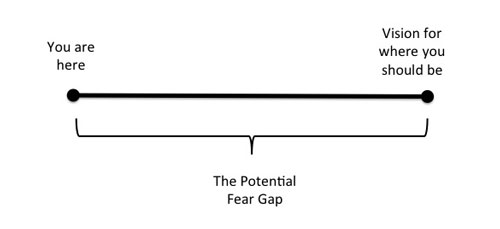For any organization to move forward, they must possess a clear and clarified vision. Even though many organizations do have a clear vision, they fail to reach it. Why?
It’s what I call The Fear Gap.

The distance between the you-are-here point and the vision of where-you-should-be point is what I call The Fear Gap. The farther the vision is from the current status quo, the more room there is for fear to enter and cause us to retreat from accomplishing the vision. We have the potential to interject our personal and organizational fears into this gap, which leads to action paralysis.
What Causes This Fear?
A large part of avoiding or overcoming The Fear Gap is knowing what triggers this response with us.
1. The perceived imminence of danger generates fear.
This doesn’t have to be a mortal concern for life and limb. It can be the perceived loss of profit or influence, bankruptcy, or simply being known as the person who led an organization into a risky endeavor and failed.
2. The perceived lack of escape routes.
If the move toward the vision seems like it has only one lane with no off ramps, and there is no reversal or change possible once the journey begins, then fear often increases.
3. Past pains.
When we perceive any environment or effort has a similar setting to something that caused us past pain, a Pavlovian-like effect occurs, and we emotionally recoil from that environment. It might be something as simple as having been bitten by a dog in childhood or something as complex as a business situation which in the past created some type of emotional pain. We instantly think, “This is just like that past situation…flee or fight it.”
4. The Unknown
When we are uncertain about something, our brain has a great degree of latitude to create what-if situations. This is a breeding ground for fear.
What Happens To Us in a Fearful State?
We are designed for self-preservation. When one of these triggers fire, our brains kick into overdrive in the frontal cortex region. Fear lives in a small almond-shaped pair of brain structures, called the amgydalae, that control your body’s panic button. The nerve junctions located there develop special sensitivity to particular sensory signals. Richard Huganir discovered an unusual protein that becomes present in the amygdalae, which creates the chemical fear reaction.
Getting Courage Back
To move our organizations to the next level, we must realize that fear is present within our team members and ourselves. To try to simply ignore it goes against how we are hard-wired and will fail immensely. We can foster and build courage. In fact, courage is measured as a dynamic trait on the Keller Influence Indicator® precisely because we realize courage is malleable, not static.
When one of the fear triggers presents itself and we begin to feel even mildly fearful of moving the organization forward, there are some helpful tactics we can use.
1. Remember it’s chemical.
Simply reminding yourself that you are experiencing an age-old chemical reaction that every other human experiences can help you set fear in its place and not let it become a driving factor for decisions. Tell yourself, this is my frontal region talking to me, and I don’t have to succumb to its urgency. My central brain region is capable of letting me make common sense decisions.
2. Remember it’s probably not life or death.
If you are making a business decision or most other decisions for that matter, keep in mind that no one’s actual life hangs in the balance. There is almost always a way towards recovery even if the worst disaster possible occurs. We, as humans, are quite resilient by nature as evidenced by millions of rags-to-riches stories.
3. Push Away the What If’s and Live in the What Is
Our brains, particularly if susceptible to anxiety, like to take us down the worst “what if”roads possible. Try to live in the what-is reality and not hypothetical what-if scenarios you self-create. Adjustment and change is typically possible and rarely are you as locked into a certain pathway as you’d like to think.
4. List out Your Fears
Capturing your fears on paper helps you see them as manageable. It greatly reduces the all-or-nothing decision that fear wants us to make and allows us to better calculate the risks of leaving the shores of the status quo.
5. Rest and Refocus
Fatigue makes cowards of us all. Fatigue + fear make idiots of us all. Whether you take time away, meditate, go on a walk or to a museum, provide your brain the opportunity to unhook itself from irrational thinking. Stimulate your brain with something other than the problem at hand. I have a friend who struggles with anxiety and started doing adventure races because it demands her mind focus on the task at hand and lessens the what-if scenarios she would concoct. While this doesn’t sound restful to most of us, this activity gives her brain a chance to rest from fear and worry.
6. Gather Fresh Information That Fosters a Victorious View
We tend to gather information that reinforces our current biases; in this case, recoiling in fear. You can always find voices in person or online that reinforce fear. Don’t believe me? Visit an online depression forum, and you’ll see 9 posts about how horrible things are and how bad an anti-depression drug’s side-effects are versus the 1 post stating this medicine or coping technique is really helping someone. We, for some strange reason, are drawn to the negative. Instead, find contrarian thought in which someone faced a similar fear gap and overcame it. This tells your brain it is possible.
7. Take the Leap
Ultimately you must influence as a leader. Take the leap even while you are afraid. Move into the fear gap, and you’ll experience the thrill of accomplishment, and the next time you face a fear gap, it will be smaller. Set sail for the vision and leave the shore of the status quo. Enjoy the journey. Laugh whenever you can and give thanks for all the progress made. Life is designed to be an adventure, and in fact, it can’t be lived any other way. You might as well find joy in it.





